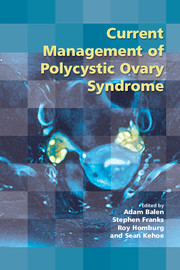Book contents
- Frontmatter
- Contents
- Participants
- Declarations of personal interest
- Preface
- 1 Overview and definitions of polycystic ovary syndrome and the polycystic ovary
- 2 Genetics and pathogenesis of polycystic ovary syndrome
- 3 Ethnic variations in the expression of polycystic ovary syndrome
- 4 Quality of life for women with polycystic ovary syndrome
- 5 Insulin resistance, the metabolic syndrome and polycystic ovary syndrome
- 6 Management of polycystic ovary syndrome through puberty and adolescence
- 7 Long-term health risks of polycystic ovary syndrome
- 8 Approaches to lifestyle management in polycystic ovary syndrome
- 9 Management of obesity in polycystic ovary syndrome, including anti-obesity drugs and bariatric surgery
- 10 Definition of hyperandrogenism
- 11 Treatment of hyperandrogenism in polycystic ovary syndrome
- 12 Choices in the treatment of anovulatory polycystic ovary syndrome
- 13 Predictors of ovarian response to ovarian stimulation: progress towards individualised treatment in ovulation induction
- 14 Surgical management of anovulatory infertility in polycystic ovary syndrome
- 15 The role of insulin-sensitising drugs in the treatment of polycystic ovary syndrome
- 16 The role of in vitro maturation of oocytes for anovulatory polycystic ovary syndrome
- 17 Acupuncture and/or herbal therapy as an alternative or complement for relief of polycystic ovary syndrome-related symptoms
- 18 Consensus views arising from the 59th Study Group: Current Management of Polycystic Ovary Syndrome
- Index
2 - Genetics and pathogenesis of polycystic ovary syndrome
Published online by Cambridge University Press: 05 July 2014
- Frontmatter
- Contents
- Participants
- Declarations of personal interest
- Preface
- 1 Overview and definitions of polycystic ovary syndrome and the polycystic ovary
- 2 Genetics and pathogenesis of polycystic ovary syndrome
- 3 Ethnic variations in the expression of polycystic ovary syndrome
- 4 Quality of life for women with polycystic ovary syndrome
- 5 Insulin resistance, the metabolic syndrome and polycystic ovary syndrome
- 6 Management of polycystic ovary syndrome through puberty and adolescence
- 7 Long-term health risks of polycystic ovary syndrome
- 8 Approaches to lifestyle management in polycystic ovary syndrome
- 9 Management of obesity in polycystic ovary syndrome, including anti-obesity drugs and bariatric surgery
- 10 Definition of hyperandrogenism
- 11 Treatment of hyperandrogenism in polycystic ovary syndrome
- 12 Choices in the treatment of anovulatory polycystic ovary syndrome
- 13 Predictors of ovarian response to ovarian stimulation: progress towards individualised treatment in ovulation induction
- 14 Surgical management of anovulatory infertility in polycystic ovary syndrome
- 15 The role of insulin-sensitising drugs in the treatment of polycystic ovary syndrome
- 16 The role of in vitro maturation of oocytes for anovulatory polycystic ovary syndrome
- 17 Acupuncture and/or herbal therapy as an alternative or complement for relief of polycystic ovary syndrome-related symptoms
- 18 Consensus views arising from the 59th Study Group: Current Management of Polycystic Ovary Syndrome
- Index
Summary
Introduction
Despite the fact that polycystic ovary syndrome (PCOS) is by far the most common endocrine disorder in women, affecting an estimated 5-10% of women of reproductive age, its aetiology and pathogenesis remain uncertain. PCOS usually presents during adolescence and is a heterogeneous syndrome that is classically characterised by features of anovulation (amenorrhoea, oligomenorrhoea, irregular cycles) together with symptoms of androgen excess (hirsutism, acne, alopecia). The most consistent biochemical abnormality is elevation of serum androgen concentrations. Luteinising hormone (LH) concentrations are often also raised, whereas levels of follicle-stimulating hormone (FSH) are normal. It is now well established that PCOS is also characterised by metabolic abnormalities, particularly insulin resistance and hyperinsulinaemia, which are associated with an increased risk of developing type 2 diabetes in later life. It is important to emphasise, however, that the syndrome is by nature heterogeneous and that the spectrum of presentation of PCOS includes women with anovulation who have no symptoms of androgen excess (although most have raised serum androgen concentrations) as well as those with hyperandrogenism but regular menses. The recognition of this heterogeneity underpins the revision of the diagnostic criteria for PCOS that resulted from the joint consensus meeting of the European Society for Human Reproduction and Embryology (ESHRE) and the American Society for Reproductive Medicine (ASRM). Thus the so-called ‘Rotterdam’ diagnostic criteria are defined by the presence of two of the three following features:
∎ polycystic ovaries
∎ anovulation
∎ androgen excess (clinical and/or biochemical).
- Type
- Chapter
- Information
- Current Management of Polycystic Ovary Syndrome , pp. 13 - 24Publisher: Cambridge University PressPrint publication year: 2010



